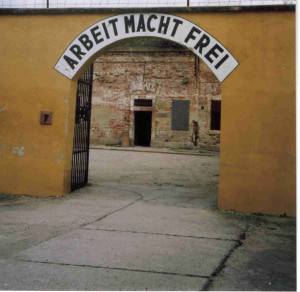Another remarkable artist who was incarcerated in Terezin was Bedřich Fritta, who was imprisoned along with Leo Haas and Otto Ungar in July 1944.
He was born Bedřich Taussig in 1906 in Weigsdorf (Višňová), Northern Bohemia and demonstrated an interest and aptitude for art. In 1930 he moved to Paris to study art, and eventually settled in Prague where he worked as a graphic designer, technical draughtsman and contributed cartoons and caricatures to satirical magazines. He preferred to be called Fritta, his pen name, and this is what he family and friends affectionately called him.
In December 1941 Fritta was sent to Terezin on one of the first transports along with other artists, engineers and doctors who were assigned to help set up the camp. His wife, Hansi, and their one year old son Tommy accompanied him to the camp.
At Terezin, Fritta was assigned as supervisor to the camp’s drawing studio, where blueprints, construction plans and technical reports were composed. Those who knew him described him as extroverted, outspoken, and strong-willed, a man of great enthusiasm. It seems that Fritta and Leo Haas were the ones who first used materials available to them to secretly depict life in the ghetto. Some of the other men who worked with them began to do the same.
In addition to his work at the camp, Fritta produced over 100 drawings and sketches in Terezin, most of which were ink drawings, finished with a paintbrush and water to add shadowy dimensions. His drawings are characterized by the interplay of light and shadow, and their haunted, despairing figures. Some of his sketches depict barracks, transports leaving the ghetto, the cafe set up in preparation for the Red Cross visit, in which solemn people sit at empty tables while a band plays.
Fritta also created a picture book for his son Tommy, a gift for the boy’s third birthday on January 22, 1944. The book, which the artist bound with heavy brown paper, was filled with colorful ink, pen and watercolor drawings accompanied by captions. Fritta depicted Tommy’s daily activities, but also images of a happy life outside of Terezin. For Tommy’s third birthday, Fritta and his wife Hansi even managed to plan a special party in the ghetto, complete with presents and a cake.
Following the Red Cross visit, Fritta and Leo Haas hid many of their drawings and paintings, Haas in the paneling of a wall, Fritta in a large tin case that he and some of his friends secretly buried. Tommy’s book was hidden in the ghetto along with Fritta’s other paintings. Soon after the Red Cross visit, Fritta, his wife Hansi, and Tommy were imprisoned in the Small Fortress along with Leo Haas, Otto Ungar and their families.
Fritta endured unimaginable suffering while imprisoned, and was savagely beaten and interrogated daily. He later contracted dysentery, which depleted all that remained of his strength. When he was moved to a cell occupied by Leo Haas, his friend was horrified at how emaciated and ill he had become. In early August both men were forced to sign an indictment stating that they were guilty of creating propaganda and distributing it abroad.
The following day, they were put on a train to Auschwitz. Fritta was suffering from severe dysentery and malnutrition and was barely able to walk or move. When the group was suddenly forced off the cars at Dresden, Haas lifted his friend onto his back and carried him off the car and through the dark streets. After a check at Gestapo headquarters, the prisoners were sent on to Auschwitz, where Fritta was taken to the infirmary. The doctor tried to keep Fritta comfortable and Haas and other friends visited him and smuggled food. But at this point, Fritta was unable to eat, and drifted in and out of consciousness. The outgoing, enthusiastic, courageous man who risked so much to reveal the truth of Terezin died eight days after arriving in Auschwitz, in late August 1944.
The artists’ wives and children were imprisoned in the Small Fortress for more than a year. Fritta’s wife Hansi died of malnutrition and disease in Terezin a few months after her husband. Their son Tommy survived the war in Terezin, an orphan at just four years of age. He was adopted by Fritta’s friend Leo Haas and his wife Erna. Haas returned to Terezin to recover their hidden paintings as soon as he could, and was successfully able to reclaim the tin box with Fritta’s works. He returned the beautiful, lovingly crafted picture book to Tommy, his last gift from the father who adored him.
Exhibition of Fritta’s Drawings
http://www.jmberlin.de/fritta/en/index.php
Tommy’s Book:
http://www.jmberlin.de/fritta/en/bilderbuch-fuer-tommy.php
Further Reading
The Artists of Terezin by Gerald Green
